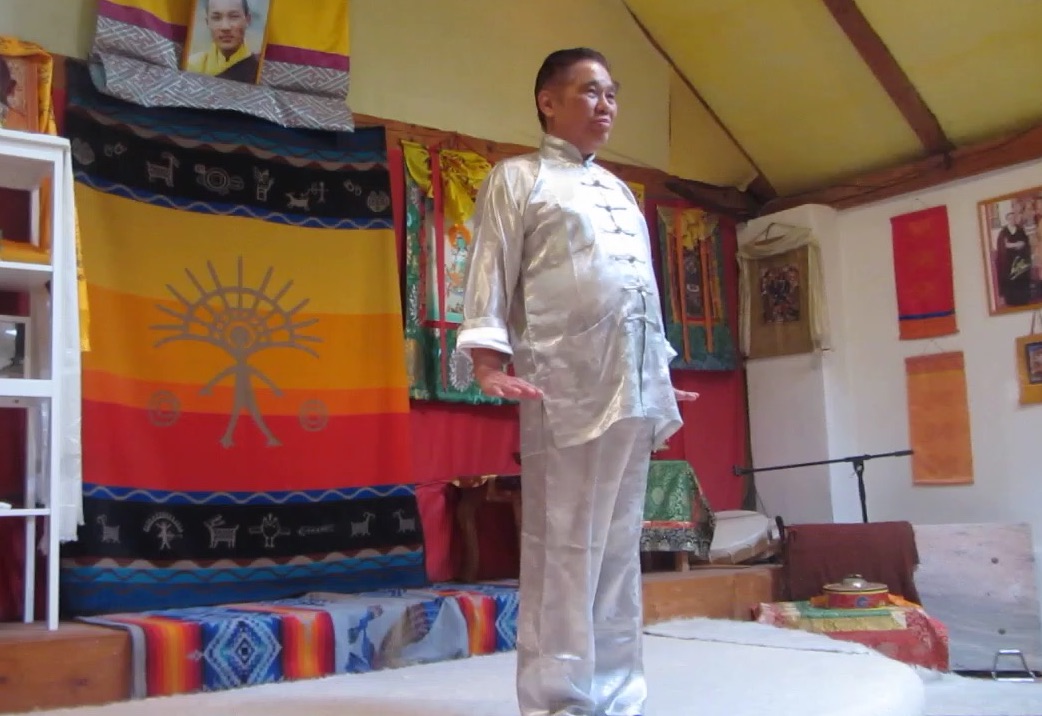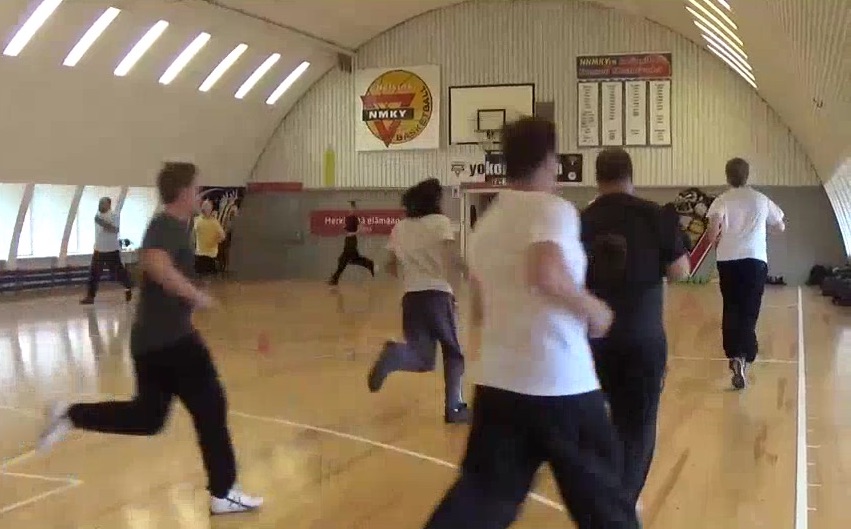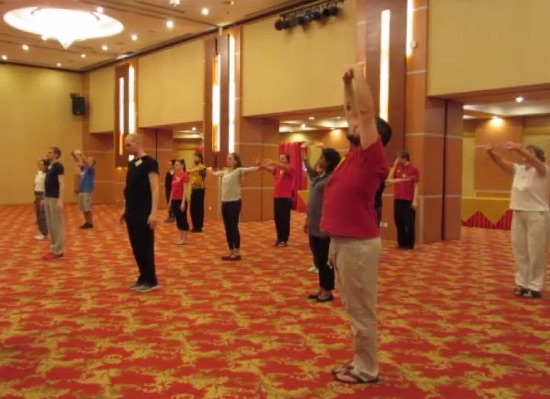SELECTION OF QUESTIONS AND ANSWERS
FEBRUARY 2022 PART 2

"Flicking Fingers"
Question 1
How are Sifu and the family doing? The grandchildren must all be growing up very quickly.
— Sifu Kevin, Shaolin Wahnam Singapore
Answer
Qigong is treating me and my family well, though I have not been able to see my grandchildren because of the world lockdown. I hope the lockdown will soon be over.
We are indeed blessed to be able to practice the Shaolin arts every day. "Being accomplished in the Shaolin arts is better than changing stones to gold by touch", so says a proverb in Chinese.
Question 2
I have also been practising my qigong with certain themes. In 2019, it was Iron Wire every day for one year, and this year (2020) it is One Finger Zen. It is not just mindlessly practising them, but as I practice these arts every day, it is as if the arts are teaching me new things and letting me gain insights. Next year (2021), I will probably work on Sinew Metamorphosis.
Answer
It is great that you practice qigong with certain themes. You must also not neglect your kungfu. Indeed I was thinking that you could write more about kungfu on Shaolin and Taijiquan.
Many people just practice external Taiji dance, missing a lot in Taijiquan. But Taijiquan demands much hard work though the rewards are enchanting.
Iron Wire is a special set, creating a lot of internal force. I remember I caused quite an "earthquake" with Taijiquan in Taiwan.
One Finger Shooting Zen is a treasure. It enables me to have internal force, which is not only good for kungfu but for daily life. I am over 75, and with good health and vitality.
Sinew Metamorphosis is very powerful, especially how we do so in Shaolin Wahnam. Just a few minutes of flicking fingers, for example, can generate so much internal force.

Art of "1000 Steps"
Question 3
I attended the One-Finger Shooting Zen course in Ireland. I noticed that in the course held in Ireland the One-Finger Shooting Zen form was much shorter than the form that you usually teach at the Intensive Shaolin Kung Fu courses.
May I ask what is the difference in terms of benefits between practicing the short form vs the long form? Do they have different goals in mind?
— Santiago, Spain
Answer
Normally, intensive courses in Malaysia are longer than regional courses in various parts of the world. Nevertheless, those of regional courses will also have the arts of the intensive courses.
In One-Finger Shooting Zen, a practitioner breathes in when the right One-Finger Zen hand form is at the chest, and breathes out with a "shss" sound when the hand form is extended out. It is repeated twice, i.e. three times in all. When it is shot out, the sound "shss" with a rather sharp sound is made.
Then a tiger-claw is made at about shoulder height to about thigh level with a "yaa" sound. In making the "yaa" sound, the lungs should vibrate.
The same procedure is repeated with the left hand.
Normally, the practitioner performs 3 times on the right and 3 times on the left alternatively. He should feel fresh and energized and should not feel tired. If there is pain in his chest, it is wrong, in which case he should stop training immediately and resume only when the pain has disappeared. He may have to clear his injury with "Lifting the Sky" or "Dancing Butterfly".
There is no difference between the long form and the short form; in fact, there is no long form and no short form. The benefits are to train flowing force and consolidated force. The practitioner should first let the force flow, and then consolidate the force. When force arrives, his index finger of each hand will vibrate involuntarily.
Question 4
The other question is regarding the Art of Thousand Steps. I did the course in Madrid. I remember that we were performing abdominal breathing and then using the energy generated to walk and run, but I am not 100% sure of this instruction.
Answer
In the Art of Thousand Steps, the practitioner practices Abdominal Breathing. Then he sends his chi to his legs. At first he runs on the spot while sending chi to his legs.
He should use about 70% of his breath, and send about 30% to his "dan tian" (or abdominal energy field). When he has used his breath, he should breathe in. When he has used about 70% of his breath, he sends about 30% to his "dan tian". He should maintain this 70% and 30% all the time.
Later he actually walks, and then runs. He can run slowly. Gradually he runs fast, then very fast. If he can run 1000 steps, he can run countless steps. He should not feel tired no matter how far he runs.

Counting leaves. Pictures taken from https://www.pics4learning.com/details.php?img=leaves28.jpg
Question 5
Several years ago my eyesight evolved to the point where I was legally blind. This regular practice has complimented the chi kung to a degree that is allowing for an unusually consistant high level of clarity, which cannot be achieved from clean diet and exercise alone.
— Trevor, Canada
Answer
When they were in school which was long ago, all my children were told to wear spectacles. But I believe in the Shaolin Eight Exercises of chi kung. I told all of them to practice the Shaolin Eight Exercises. They did and none of them today wear spectacles.
I work with a computer the whole day. But my eyesight is fine. I don't have to wear spectacles. I do the Shaolin Eight Exercises.
I have described the Shaolin Eight Exercises but I don't know exactly where they are as my "Question and Answer Series" is extensive. The Shaolin Eight Exercises are wonderful.
Go to https://shaolin.org/answers/overview.html and "SEARCH SHAOLIN.ORG". Type "Shaolin Eye Eight Exercises" in the search box and press. You will find many articles on the Shaolin Eye Eight Exercises which are safe to practice on your own.
Question 6
I enjoy my relationships to the wildlife that join me in practice, and indeed even when I simply go for walks in the woods.
Answer
Wildlife may come nearby when you practice Shaolin chi kung. They are sensitive to good chi (or energy). Enjoy your chi flow.
You should come for my Intensive Chi Kung Course when it is offered, but I don't know when I shall offer it. Please see my website.

Intensive Chi Kung Course
Question 7
I see chi kung in yoga, and yoga in chi kung. My good friend, who has trained in India in yoga practice, and I have often discussed the similarities and differences.
Answer
Chi kung and yoga have similar aims though the details are different. Pranayama in yoga is similar to dao-ying exercises in chi kung, like the Eighteen Lohan Hands; and raja yoga is similar to meditation.
Question 8
Is there a history or form of chi kung that may be accessed online or I buy a book you could recommend? It seems to me a connection between a practice of chi kung that forms a bridge of sorts between the conscious and unconscious aspects of chi flow as a means of communication of the nature of living things by its energy.
Answer
The main thing in chi kung is skills rather than techniques. This is something many people find it hard to understand. They think wrongly that once they know the techniques, they may derive the benefits of chi kung if they practice long enough.
But this is not so, which is obvious to us in Shaolin Wahnam, the school that I have founded and which dedicates to the practice of chi kung and kungfu. To get the benefits, practitioners have to learn from a genuine master who is willing to teach them. Most genuine masters, however, are unwilling to teach, and there are a lot of bogus masters around.
If you have any questions, please e-mail them to Grandmaster Wong via his Secretary at stating your name, country and e-mail address.
LINKS
Selected Reading
- One-Finger Shooting Zen -- the Treasure of Shaolin Wahnam
- The Iron Wire Set
- Art of 100 Steps
- The Tame Old River
- Simply Delicious
